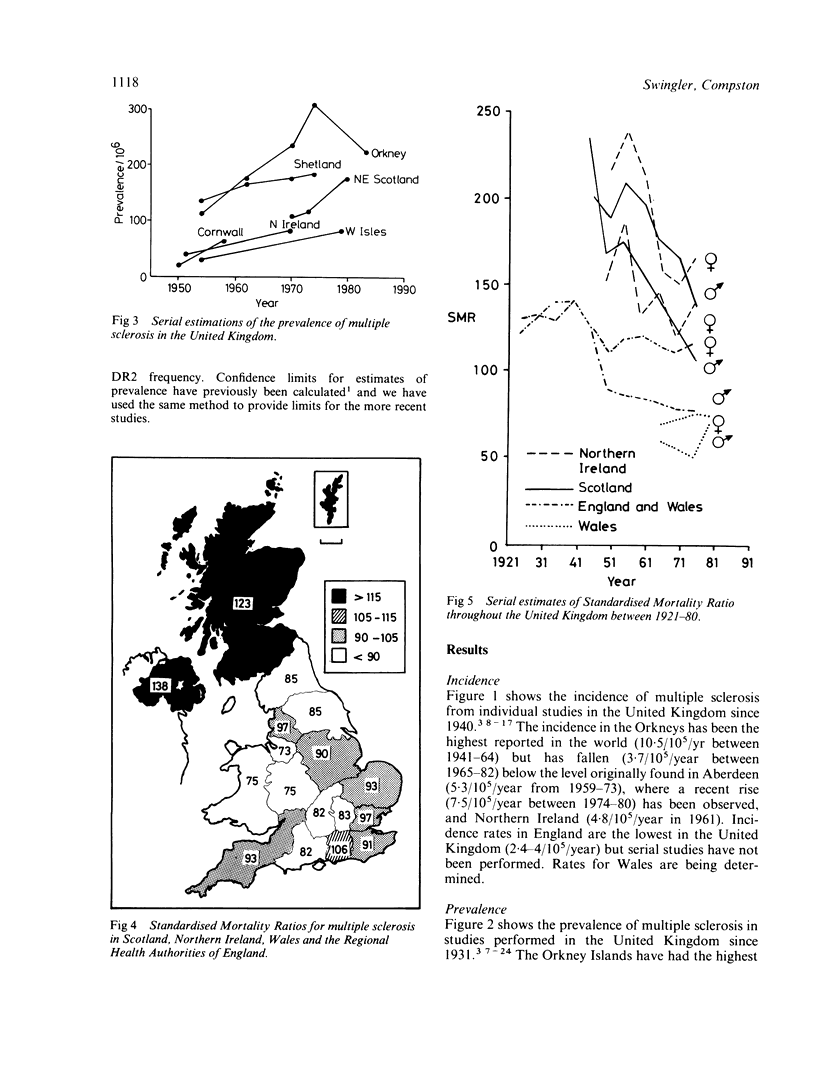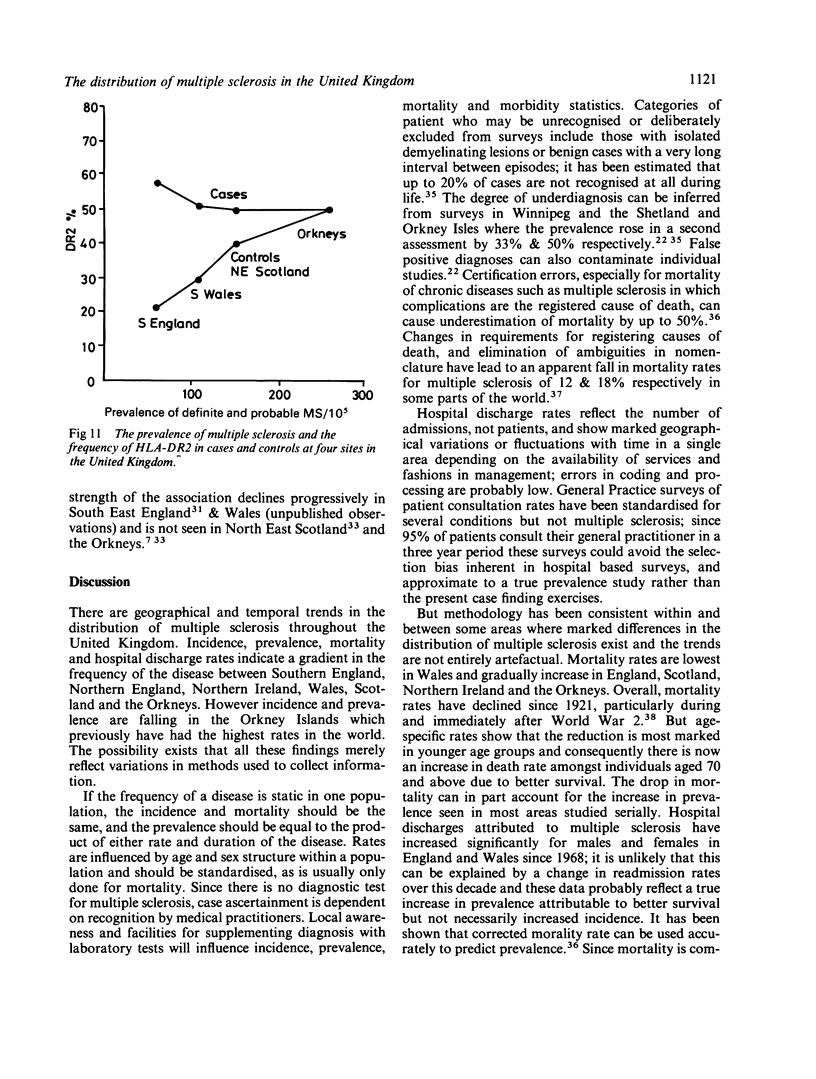Abstract
Parts of the United Kingdom have the highest incidence, prevalence and mortality rates for multiple sclerosis in the world. Although methods of ascertainment are not standardised, regional differences and changes with time are present for each of these statistics. Mortality has declined, whereas prevalence and hospital discharge rates have increased owing in part to the improved survival but also to better case ascertainment. The gradient in prevalence seen between Southern England (63/10(5)), Northern England and Northern Ireland (76-79/10(5)), Wales (c. 113/10(5)), North-East Scotland (155/10(5)) and the Orkneys (258/10(5)) can in part be attributed to varying methods of ascertainment but correlates with regional differences in the frequency of HLA-DR2 in normal individuals (21-50%). However no HLA-DR2 association is observed in parts of Scotland, where the prevalence is the highest in the United Kingdom, because HLA-DR2 and linked genes occur in up to 50% of the normal population from these areas. If the aetiology of multiple sclerosis is multifactorial the frequency of the disease will increase where susceptibility genes are common because the probability of concurrence of the remaining critical events is high; conversely when each aetiological agent is infrequent the chance of them all occurring in the same individual and therefore incidence of the disease are both lower. The fall in incidence observed in the Orkney Islands, possibly reflecting decline in an exogenous agent interacting with susceptibility factors, is consistent with this multifactorial hypothesis.
Full text
PDF









Selected References
These references are in PubMed. This may not be the complete list of references from this article.
- Cohen D., Cohen O., Marcadet A., Massart C., Lathrop M., Deschamps I., Hors J., Schuller E., Dausset J. Class II HLA-DC beta-chain DNA restriction fragments differentiate among HLA-DR2 individuals in insulin-dependent diabetes and multiple sclerosis. Proc Natl Acad Sci U S A. 1984 Mar;81(6):1774–1778. doi: 10.1073/pnas.81.6.1774. [DOI] [PMC free article] [PubMed] [Google Scholar]
- Compston A. Multiple sclerosis in the Orkneys. Lancet. 1981 Jul 11;2(8237):98–98. doi: 10.1016/s0140-6736(81)90454-2. [DOI] [PubMed] [Google Scholar]
- Compston D. A., Batchelor J. R., McDonald W. I. B-lymphocyte alloantigens associated with multiple sclerosis. Lancet. 1976 Dec 11;2(7998):1261–1265. doi: 10.1016/s0140-6736(76)92027-4. [DOI] [PubMed] [Google Scholar]
- Cook S. D., Cromarty J. I., Tapp W., Poskanzer D., Walker J. D., Dowling P. C. Declining incidence of multiple sclerosis in the Orkney Islands. Neurology. 1985 Apr;35(4):545–551. doi: 10.1212/wnl.35.4.545. [DOI] [PubMed] [Google Scholar]
- Dean G., Goodall J., Downie A. The prevalence of multiple sclerosis in the Outer Hebrides compared with north-east Scotland and the Orkney and Shetland Islands. J Epidemiol Community Health. 1981 Jun;35(2):110–113. doi: 10.1136/jech.35.2.110. [DOI] [PMC free article] [PubMed] [Google Scholar]
- Downie A. W., Phadke J. G. The chief scientist reports ... multiple sclerosis in North East Scotland. Health Bull (Edinb) 1984 May;42(3):151–156. [PubMed] [Google Scholar]
- HARGREAVES E. R. Epidemiological studies in Cornwall. Proc R Soc Med. 1961 Mar;54:209–216. doi: 10.1177/003591576105400307. [DOI] [PMC free article] [PubMed] [Google Scholar]
- Kurtzke J. F. A reassessment of the distribution of multiple sclerosis. Part one. Acta Neurol Scand. 1975 Feb;51(2):110–136. doi: 10.1111/j.1600-0404.1975.tb01364.x. [DOI] [PubMed] [Google Scholar]
- Kurtzke J. F., Gudmundsson K. R., Bergmann S. Multiple sclerosis in Iceland: 1. Evidence of a postwar epidemic. Neurology. 1982 Feb;32(2):143–150. doi: 10.1212/wnl.32.2.143. [DOI] [PubMed] [Google Scholar]
- Mackay R. P., Hirano A. Forms of benign multiple sclerosis. Report of two "clinically silent" cases discovered at autopsy. Arch Neurol. 1967 Dec;17(6):588–600. doi: 10.1001/archneur.1967.00470300030007. [DOI] [PubMed] [Google Scholar]
- McCoubrie M., Shuttleworth D. Prevalence of multiple sclerosis in West Yorkshire. Br Med J. 1978 Aug 19;2(6136):570–570. doi: 10.1136/bmj.2.6136.570-b. [DOI] [PMC free article] [PubMed] [Google Scholar]
- Poskanzer D. C., Prenney L. B., Sheridan J. L., Kondy J. Y. Multiple sclerosis in the Orkney and Shetland Islands. I: Epidemiology, clinical factors, and methodology. J Epidemiol Community Health. 1980 Dec;34(4):229–239. doi: 10.1136/jech.34.4.229. [DOI] [PMC free article] [PubMed] [Google Scholar]
- Poskanzer D. C., Terasaki P. I., Prenney L. B., Sheridan J. L., Park M. S. Multiple sclerosis in the Orkney and Shetland Islands. III: Histocompatibility determinants. J Epidemiol Community Health. 1980 Dec;34(4):253–257. doi: 10.1136/jech.34.4.253. [DOI] [PMC free article] [PubMed] [Google Scholar]
- Roberts D. F., Roberts M. J., Poskanzer D. C. Genetic analysis of multiple sclerosis in Orkney. J Epidemiol Community Health. 1979 Dec;33(4):229–235. doi: 10.1136/jech.33.4.229. [DOI] [PMC free article] [PubMed] [Google Scholar]
- STAZIO A., KURLAND L. T., BELL L. G., SAUNDERS M. G., ROGOT E. MULTIPLE SCLEROSIS IN WINNIPEG, MANITOBA: METHODOLOGICAL CONSIDERATIONS OF EPIDEMIOLOGIC SURVEY. TEN YEAR FOLLOW-UP OF A COMMUNITY WIDE STUDY, AND POPULATION RE-SURVEY. J Chronic Dis. 1964 May;17:415–438. doi: 10.1016/0021-9681(64)90102-x. [DOI] [PubMed] [Google Scholar]
- SUTHERLAND J. M. Observations on the prevalence of multiple sclerosis in Northern Scotland. Brain. 1956 Dec;79(4):635–654. doi: 10.1093/brain/79.4.635. [DOI] [PubMed] [Google Scholar]
- Shepherd D. I., Downie A. W. A further prevalence study of multiple sclerosis in north-east Scotland. J Neurol Neurosurg Psychiatry. 1980 Apr;43(4):310–315. doi: 10.1136/jnnp.43.4.310. [DOI] [PMC free article] [PubMed] [Google Scholar]
- Shepherd D. I., Downie A. W. Prevalence of multiple sclerosis in north-east Scotland. Br Med J. 1978 Jul 29;2(6133):314–316. doi: 10.1136/bmj.2.6133.314. [DOI] [PMC free article] [PubMed] [Google Scholar]


